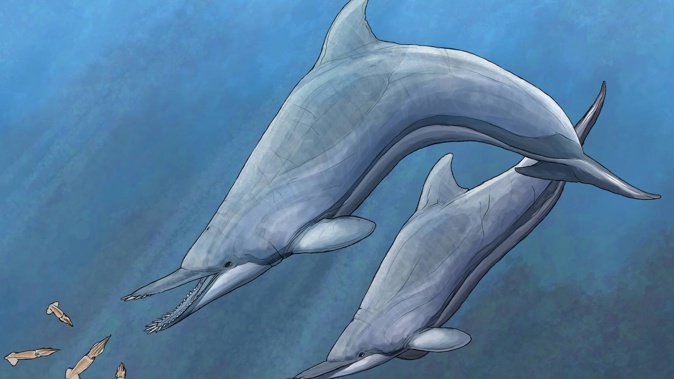
Scientists have described a new dolphin species armed with protruding, tusk-like teeth for swift and violent attacks on prey – but we’re about 25 million years too late to see it.
Described in a just-published paper, the ancient dolphin was identified from fossil remains found in a fallen rock in Otago’s Awamoko Valley, within the recently designated UNESCO Waitaki Whitestone Geopark, back in December 1998.
While most of the fossil dolphin’s skeleton wasn’t complete, with just a few ribs and vertebrae remaining, its skull and jaw was “exceptionally well preserved”, said the paper’s lead author and Otago University researcher Ambre Coste.
That enabled the researchers to determine the species – formally named Nihohae matakoi and first found by paleontologist Seabourne Rust - was unlike any of the dolphins or whales found in our oceans today.
“This ancient species of dolphin is very unusual as it has teeth at the front of its mouth that stick straight out horizontally, something not seen in any modern dolphins,” Coste said.
“It would likely have measured slightly over two metres long, had a slightly longer neck than modern dolphins and rounded paddle like front fins.”
/cloudfront-ap-southeast-2.images.arcpublishing.com/nzme/LKWKY6D7CNC4NFKSFWA5IKWNSQ.jpg)
The skull of the dolphin species – named Nihohae matakoi - had been incredibly well preserved within fallen rock in the recently designated UNESCO Waitaki Whitestone Geopark in Otago. Photo / Supplied
It would have lived off the coast of ancient New Zealand, which, at the time of the Late Oligocene period 26 to 30 million years ago, was mostly underwater.
“The interesting aspect of this dolphin is that its teeth suggest a new feeding method not previously described in marine mammals,” Coste said.
“We suggest that it would have rapidly swung its head from side to side to injure or stun prey, making them easier to catch and eat.”
As it showed no evidence of wear on any of its teeth, it was believed to have hunted small, soft-bodied prey like squid, with little chewing and tearing involved.
Its genus name Nihohae translated to “teeth” and “slashing” while its species name matakoi referred to mata for face and point, and koi, for sharp.
“This lack of wear marks shows it didn’t use them to rummage through sand and the fact the front teeth are so flat indicates they wouldn’t have been useful for gripping prey like the Ganges river dolphin does.”
Ultimately, Coste said the new species offered “a glimpse into the amazing diversity of ancient dolphin species and their incredible adaptations for hunting and survival”.
Among the team who first collected the fossil was study co-author and renowned Otago University paleontologist Professor Ewan Fordyce.
Having retired in 2021 after a 60-year career, Fordyce has been involved in numerous discoveries of prehistoric whales, dolphins and penguins in New Zealand.
This year, his enormous contributions to marine vertebrate paleontology were honoured with researchers naming after him the world’s largest penguin – the recently-discovered, 150kg Kumimanu fordycei.
Much of his work was focused on the Waitaki Valley, thought to have once been a rich feeding or breeding ground in a vast sheltered embayment, given the treasure trove of fossils preserved in its rocks.
The area continued to offer a window to an era 24 to 30 million years ago - almost halfway back to the age of the dinosaurs - and was considered by scientists as one of the most important sites in the world for understanding the evolution of marine life today.
Take your Radio, Podcasts and Music with you









